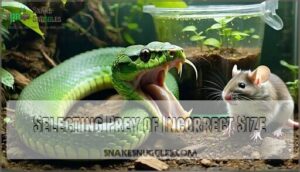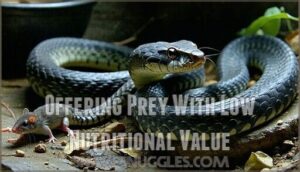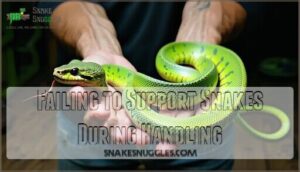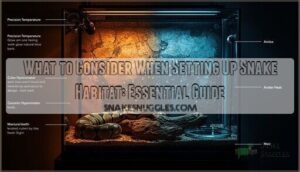This site is supported by our readers. We may earn a commission, at no cost to you, if you purchase through links.

Don’t forget that different snake species have unique dietary needs – what works for a ball python won’t suit a corn snake.
Many owners fall into the trap of overfeeding, which can lead to obesity just as easily as in mammals.
Proper feeding technique isn’t just about what you feed, but also when and how, and the difference between a thriving snake and a stressed one often comes down to these seemingly small details.
Table Of Contents
- Key Takeaways
- Feeding Frequency Mistakes
- Poor Prey Quality Issues
- Handling Snakes Incorrectly
- Environmental Feeding Mistakes
- Health and Hygiene Oversights
- Frequently Asked Questions (FAQs)
- What not to do when feeding a snake?
- What foods are toxic to snakes?
- What is the best thing to feed a snake?
- Do snakes eat pre-killed prey?
- What happens if you feed a snake too often?
- How do you feed a snake?
- What are the most common corn snake feeding mistakes?
- How do you properly feed a snake?
- How to feed a stubborn snake?
- Why shouldn’t you handle a snake after feeding?
- Conclusion
Key Takeaways
- You’ll harm your snake’s health by using improper feeding frequency—hatchlings need more frequent meals for development while adults require less food to prevent obesity and metabolic disorders.
- You’re risking digestive problems if you don’t select appropriate prey size (around 1.5 times your snake’s widest point) and quality, or if you fail to properly thaw frozen rodents.
- You’ll increase stress and potential regurgitation when you handle your snake immediately after feeding—always wait 48-72 hours before handling to allow for proper digestion.
- You’re compromising your snake’s appetite and overall health if you don’t maintain proper environmental conditions, including correct temperature gradients, adequate humidity levels, and clean feeding areas.
Feeding Frequency Mistakes
Feeding your snake too often or not often enough can lead to unnecessary stress and health problems.
Understanding their natural eating habits and adapting to their life stage will help you avoid common feeding frequency mistakes, which can be mitigated by recognizing complete concepts.
Feeding Young Snakes Too Infrequently
Underfeeding snakes, especially young ones, can lead to growth stunting, nutritional deficiencies, and delayed maturity.
Here’s a short, engaging blockquote in the same tone as the original paragraph:
Undernourished young snakes face a triple threat: stunted growth, nutritional gaps, and developmental delays that can impact their entire lives.
Hatchlings need a consistent snake feeding schedule, often twice weekly, to support organ development and long-term health.
Skipping meals disrupts their snake growth and may harm their future well-being.
Stick to a regular feeding frequency for snakes, ensuring proper hatchling care and a strong start in life.
Proper feeding involves understanding prey size guidelines to prevent injury.
Feeding Adult Snakes Too Frequently
Overfeeding snakes can lead to serious problems like obesity in snakes, organ stress, and metabolic disorders.
Adult snakes need less food, as frequent meals can cause regurgitation issues and activity reduction.
A proper snake diet means balancing feeding frequency, and to avoid this common snake feeding mistake, one should consult a vet to tailor a schedule for your pet’s size and needs, considering factors like metabolic disorders and the importance of a well-planned diet to prevent issues such as regurgitation.
Adjusting Feeding Schedules for Breeding Seasons
Breeding season brings seasonal variations to snake feeding.
Males often lose appetite while seeking mates, while females need extra energy for gestation and post-laying recovery.
Adjust your feeding schedule accordingly—offer hatchlings routine meals but reduce feeding frequency for males.
For females, increase portions during reproduction to support their needs.
Observing behavior helps tailor feeding frequency snakes require during this period.
Inadequate Feeding During Shedding
During shedding, snakes often experience appetite loss due to dermal discomfort and visual impairment.
This temporary food refusal isn’t unusual, so focus on stress reduction.
Verify proper humidity and hydration—critical for snake health.
Avoid offering prey until shedding’s complete, as eating can add to stress.
Patience and observation go a long way in supporting your snake’s natural rhythms.
Poor Prey Quality Issues
Feeding your snake poor-quality prey can lead to nutritional deficiencies and health problems over time.
Make sure the prey is the right size, properly prepared, and provides the nutrients your snake needs to thrive.
Selecting Prey of Incorrect Size
Picking the correct prey size is a balancing act—too large, and you risk stress or injury; too small, and nutritional deficiencies arise.
Stick to prey roughly 1.5 times your snake’s widest point.
- Too big: Overfeeding risks like regurgitation or injuries.
- Too small: Watch for underfeeding signs, like poor growth.
- Species-specific needs: Match rodent prey to natural diets.
Offering Prey With Low Nutritional Value
It’s not just about size—nutritional value counts too.
An improper snake diet with low-nutrition prey can lead to vitamin deficiencies, obesity in snakes, and slow growth.
Prey rotation and dietary variety help meet prey preferences and snake nutrition needs.
If unsure, consult a vet.
Avoid nutritional deficiencies by researching species-specific diets and always choosing quality prey over convenience.
Ensuring proper snake prey nutrition is essential for their health.
Improper Thawing and Preparation of Frozen Prey
Thawing frozen snake food the wrong way can cause bacterial contamination or nutrient loss, making prey less appealing to your snake.
Avoid using hot water or leaving frozen rodents at room temperature too long.
Instead, thaw in a fridge or warm water under supervision, ensuring proper prey temperature.
Refreezing is a no-go—it risks creating an improper snake diet.
Failure to Rotate Prey Items
Feeding your snake the same prey repeatedly can lead to dietary deficiencies and food imbalance.
Nutritional diversity is key to avoiding long-term health consequences.
Rotate prey items for variety and balance:
- Alternate mice and rats.
- Occasionally offer chicks or fish, if species-appropriate.
- Use frozen snake food of different types.
- Choose prey sizes carefully for each feeding.
- Consult experts for personalized advice.
Providing secure hides addresses snake’s stress and anxiety to ensure a healthy environment, which is crucial for preventing long-term health consequences and promoting overall well-being with nutritional diversity.
Handling Snakes Incorrectly
Handling your snake the wrong way can lead to stress, injuries, or missed meals.
By focusing on proper techniques, you’ll keep your pet comfortable, safe, and more likely to eat without hesitation.
Handling Snakes Immediately After Feeding
Handling snakes immediately after feeding isn’t safe for them.
Swallowing whole means snakes need time to digest without disturbance.
Handling risks regurgitation, digestion interruption, or internal injury.
Safe handling starts with patience—wait 48–72 hours, especially for larger meals.
Stress reduction is key; snakes can feel vulnerable post-meal.
Give them space for proper digestion and avoid unnecessary handling, as this allows for proper digestion.
Failing to Support Snakes During Handling
When handling your snake, always provide a secure grip and full body support to prevent stress or injury.
Imagine balancing a fragile heirloom—snakes need that same calm approach. Poor body support may trigger handling stress, affecting snake behavior and even feeding routines.
A well-supported snake feels safer and is less likely to react defensively, improving interactions overall. Before handling, it’s wise to verify snake body language to guarantee they’re relaxed, ensuring a positive interaction and reducing the risk of defensive behavior.
Incorrect Handling During Feeding Sessions
Improper handling during feeding sessions can spark snake feeding aggression and stress.
Avoid reaching into the enclosure while they eat—this invades their space, creating a stressful environment.
Handling after feeding can cause regurgitation, so give them time to digest.
Observation is key—stay calm and watch for signs of discomfort.
Frequent disturbances may lead to force-feeding risks or unsafe reactions.
Environmental Feeding Mistakes
Your snake’s environment plays a big role in their appetite and overall well-being, so it’s essential to get it right.
Mistakes like improper temperatures, low humidity, or a poorly set-up enclosure can leave your pet stressed and uninterested in food, which affects their overall well-being.
Providing Inadequate Water and Humidity
A proper water bowl size and humidity levels make all the difference in snake care.
If shedding issues arise or you spot dehydration signs, check the humidity control.
Mist the enclosure as needed, but don’t overdo it.
Snakes thrive in balanced environments, so monitor humidity levels closely to avoid common snake feeding mistakes from improper snake environment management.
Water snakes, often recommended for beginners, require specific habitat conditions to thrive.
Failing to Maintain Proper Temperature
Without proper temperature gradients, your snake might skip meals or feel stressed.
A basking spot should stay warm while allowing cooler areas for nighttime drops.
Verify that your heat source connects to a reliable thermostat for accuracy.
Snake feeding mistakes, like overlooking temperature needs, can disrupt routines.
Successful ball python feeding hinges on maintaining the ideal snake temperature to mimic their natural habitat, and it is crucial to avoid snake feeding mistakes by ensuring the right conditions, including a proper basking spot.
Neglecting to Monitor Environmental Conditions
Neglecting to monitor temperature gradients or humidity levels in your snake enclosure can cause stress and appetite loss.
Small changes, like inconsistent lighting schedules or improper hiding spots, may disrupt feeding. Even ball python feeding success relies on stable conditions.
Always check environmental factors regularly—your pet’s comfort and eating habits depend on it. Don’t let avoidable snake feeding mistakes slide!
Maintaining proper hygiene is also essential, so sanitize feeding equipment regularly, which is crucial for your pet’s overall health and well-being.
Incorrect Enclosure Setup and Maintenance
Snake stress often starts with the wrong enclosure setup. Poor enclosure size, inadequate hides, or incorrect temperature gradients can disrupt feeding.
Focus on these basics:
- Verify a proper temperature gradient with a warm side and a cool side.
- Maintain correct humidity levels to support shedding and appetite.
- Provide spacious hides to make your snake feel safe and secure.
By following these steps, you can help prevent snake stress and ensure your pet’s well-being, starting with a proper enclosure setup that includes a correct humidity levels.
Health and Hygiene Oversights
Keeping your snake’s feeding area clean and equipment sanitized isn’t just good housekeeping—it helps prevent illness and keeps your pet thriving.
Regular attention to hygiene and monitoring your snake’s health can save you from bigger problems down the road, which is crucial for keeping your pet thriving.
Neglecting to Clean Feeding Areas
Bacteria buildup, waste accumulation, and mold growth in unclean feeding areas can harm your snake’s health.
Leftover prey items attract pests and increase parasite risk.
Prioritize snake feeding hygiene by cleaning food dishes, removing scraps, and wiping surfaces after meals.
A clean setup guarantees better snake feeding sanitation, preventing snake feeding problems while keeping your pet safe and stress-free.
Failing to Sanitize Feeding Equipment
Unclean feeding tools can foster bacteria buildup, risking snake disease. Ignoring snake feeding hygiene may lead to cross-contamination risks and even parasite transmission.
Keep it clean:
- Wash utensils after every use with reptile-safe cleaning solutions.
- Store tools properly to avoid contamination.
- Prioritize snake feeding cleanliness—taking shortcuts here threatens your snake’s health.
To maintain a healthy environment, consider using a specialized reptile cleaner. Clean gear matters and snake feeding sanitation isn’t optional!
Improper Disposal of Prey Remains
Leaving prey remains in your snake’s enclosure invites trouble on multiple fronts.
Uneaten food quickly becomes a breeding ground for bacterial growth and attracts pests like flies and rodents.
Beyond the obvious odor control issues, decaying prey can transmit diseases to your snake.
Always remove uneaten prey within 24 hours and dispose of it properly to maintain snake feeding safety and cleanliness—some regions even have legal repercussions for improper disposal.
Failure to Monitor Snake Health and Behavior
Many snake owners overlook subtle behavior cues that signal potential health issues.
Watch for lethargy, excessive hiding, or water-soaking, which may indicate mites, stress, or poor husbandry conditions.
Difficulty shedding often points to husbandry problems or nutritional deficiencies.
Monitor your pet’s appetite changes and weight regularly.
If you notice pink skin along the underside or prolonged inappetence, don’t wait—schedule vet consultations immediately.
Regular enclosure observation helps catch snake illness before it becomes serious, by allowing you to identify issues such as poor husbandry conditions or mites early on.
Frequently Asked Questions (FAQs)
What not to do when feeding a snake?
When your slithery friend is hungry, don’t handle them during meals, force-feed, or offer prey that’s too large.
Also, avoid feeding in their main enclosure or disturbing them after they’ve eaten, as this can be considered disturbing them.
What foods are toxic to snakes?
You should never feed your snake insects sprayed with pesticides, toxic plants, or processed human foods containing salt, sugar, or preservatives.
Dairy, alcohol, and caffeine-containing foods are also harmful to your reptilian friend.
What is the best thing to feed a snake?
Like choosing the right fuel for a high-performance car, your snake needs species-appropriate prey.
Feed pre-killed rodents sized appropriately for your snake’s body diameter (no larger than 5 times) to guarantee proper nutrition and digestion.
Do snakes eat pre-killed prey?
Yes, snakes can eat pre-killed prey.
You’ll find many species adapt well to this feeding method, which is safer for your pet as it eliminates the risk of injury from live prey fighting back.
What happens if you feed a snake too often?
Overfeeding your snake can lead to obesity, regurgitation, and metabolic disorders.
You’ll notice undigested food, sluggish behavior, and visible fat rolls.
Feed appropriate-sized prey at species-specific intervals to maintain proper health.
How do you feed a snake?
As cool as a cucumber, you’ll need to offer appropriate-sized prey with tongs.
Place the food near your snake, never handling them afterward.
Make certain proper temperature and a quiet environment during feeding time.
What are the most common corn snake feeding mistakes?
Common corn snake feeding mistakes include offering prey that’s too large, handling after meals, feeding live rodents unsupervised, incorrect feeding frequency, and not providing proper heating which affects digestion.
You’ll need appropriate-sized frozen-thawed mice instead.
How do you properly feed a snake?
Feed your snake appropriately sized prey (not larger than 5 times their body width), in a quiet environment, using tongs.
Maintain proper temperature and humidity, and don’t handle them during or after feeding.
How to feed a stubborn snake?
Like coaxing a shy friend, offer pre-killed prey in a dark, quiet container.
Try scenting with fish, braining techniques, or different prey types.
Maintain proper temperature and minimize handling until feeding habits establish.
Why shouldn’t you handle a snake after feeding?
Handling your snake too soon after feeding can cause regurgitation or digestive issues. You’ll want to give your pet 24-48 hours of complete rest while they digest their meal undisturbed.
Conclusion
Like a caring shepherd guides their flock, you must navigate the complex terrain of snake feeding mistakes to avoid.
By maintaining proper feeding frequency, selecting quality prey, handling with care, and monitoring environmental conditions, you’re setting your serpent up for success.
Remember, your reptilian companion’s health directly reflects your diligence as an owner.
With these feeding principles mastered, you’ll enjoy many healthy years together with your slithering friend.
- https://www.evolutionreptiles.co.uk/blog/feeding-corn-snakes-preventing-obesity-and-promote-healthy-nutrition/?srsltid=AfmBOooJNZk9EbaMLxi0xv3npTkW4KVjqKmfsxkvrXTnRC8zSOfgQRQ3
- https://www.lllreptile.com/articles/130-feeding-stubborn-snakes/?%2F=&srsltid=AfmBOoqBXrE42oqQMEkZuw3HZqpkU94hU5MWIFcf6l13Frep414cmMhy
- https://community.morphmarket.com/t/picky-un-hungry-snakes-your-best-tips-and-stories/30127
- https://vcahospitals.com/know-your-pet/snakes-feeding
- https://www.quora.com/What-are-the-most-common-mistakes-a-new-pet-snake-owner-makes
















